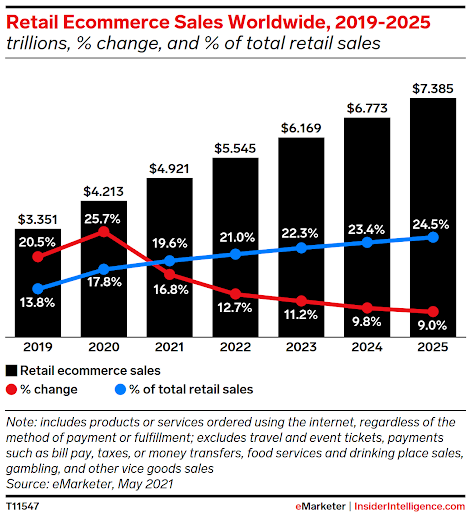The share of the retail space that’s moved to eCommerce is rapidly increasing. Between 2019 and 2020, there was a massive 77% upturn in total eCommerce spending.
While this increase was largely attributable to the pandemic, it followed a long-running trend that continues and shows no sign of stopping. According to eMarketer, global eCommerce sales are predicted to exceed $7.4 trillion by the end of 2025.

The ability to browse from anywhere, benefit from personalized product recommendations, and use contactless payments has made many consumers turn entirely to eCommerce. Customer support may also be more convenient as there’s no need to travel to a physical store to ask for help.
This shift benefits both customers and businesses. With an eCommerce app, you can reach potential customers regardless of their location or time zone. You can also integrate your app into your digital marketing strategy e.g. by including links to your app directly in your marketing content and sales funnels.
Things to consider before developing an eCommerce app
There are many advantages of having an eCommerce app, but what do you need to consider when planning your app development strategy?
1. The intended purpose of the app
Although having an app can be hugely beneficial, many businesses develop ones that contribute little to their overall strategy or even have a negative effect. An app that customers find confusing or unnecessary will seem unprofessional and can damage your brand reputation.
The best way to avoid this is to be clear from the start on the exact purpose of your app. There is an important distinction between different eCommerce apps. Some are solely for shopping, while others also allow trading.
If you’re planning an app for an existing store, you may only need it to be a shopping platform. If, on the other hand, you’re creating a new business centered around this app, it’s worth considering both options. The required architecture of the app will vary depending on which of the two you choose.
2. Your target audience

If you’re creating an app for an existing business, you can use your existing buyer personas to help identify your target audience. Make a list of the features your target buyer would appreciate. This will also help you later when it’s time to market your app.
If you’re building a business model around the app specifically, think about what products or services you’ll be selling and who your customers will be. You can use keyword research SEO strategies to find what products your target audience is searching for.
If you need to develop a new buyer persona, list attributes such as their age, gender, occupation, interests, and—perhaps most importantly—budget. This will help you price your products (even if your business also has physical stores, prices may not be the same) and work out what features your app needs.
3. Your competitors

To work out your niche, you first need to research your competitors. The competition for an online platform can be very different from that of a physical store. Geographical proximity is a much less relevant factor when shopping on the internet, so instead, look for sites and apps selling similar products to those you plan to.
Once you’ve identified the competition, list the most useful features of their sites or apps as well as those that are missing or underdeveloped. This will help you get an idea of what features to include in your app.
4. Your budget

Budgets for app development can vary widely, as can the cost of hiring developers (unless, of course, you have the talent and resources to develop your app in-house).
Generally speaking, you can expect to pay software developers anything from $40 to $300 an hour, so it’s worth shopping around.
Investing in mobile app testing services early on can prevent you from having to fix issues later.
What makes a successful eCommerce app?
When designing an eCommerce app, there are three key attributes that determine its success: security, stability, and scalability.
Security

Sufficient security is vital for any website or app, but it’s especially crucial for eCommerce platforms. To use an eCommerce app, customers must input personal data including bank account details as well as names and addresses. This makes eCommerce platforms particularly attractive targets for hackers and cybercriminals.
Customers expect watertight security if they’re to trust your platform (and, therefore, your company). It’s extremely important that you take no risks here. Choosing unreliable security solutions just to save on expenses may have disastrous consequences for your brand and customers.
Scalability
Chances are, you want your business to grow over time. This means you have to be prepared for more and more customers to be using your app, and put in place structures that enable your app to handle this growth.
First, you should forecast your predicted growth rates. Then, you’ll need to make sure architecture can run smoothly even if growth exceeds your projections. This brings us on to the next point…
Stability
The stability of an app refers to its ability to run smoothly regardless of factors such as how much traffic it receives. You’ll need to make sure your app is stable enough to handle increased visitors. You can do this by choosing a server to host your app that can manage a large number of concurrent users (people using the app at the same time as each other).
Stability also includes resilience against unexpected crises such as large-scale power outages. Unlike the pandemic, not every crisis will necessarily benefit eCommerce. In addition to robust app architecture, business continuity solutions can be particularly helpful for web-based businesses.
How to develop an eCommerce app

Once you’ve carried out your research and determined the purpose and objectives of your app, it’s time to start putting your plan into action. Here’s how to do it.
1. Choose a platform
There are two broad types of eCommerce app - progressive web apps (or PWAs) and native apps. PWAs can be accessed through browsers, while native apps are created for iOS and/or Android and must be downloaded from app stores.
As well as the technical requirements, you should consider which platform or platforms your target audience uses. Many companies offer versions of their app as PWAs and as native apps for iOS and Android, in order to reach the largest number of customers.
2. Plan the tech stack
The technical components of your app are collectively known as the “tech stack”. Tech stacks typically include the following:
- The front-end interface (what the end-user interacts with), also known as the UI (user interface)
- The back-end (the code and processing that power the app)
- The development environment (the platform/s used to build the app itself)
- Supporting tools (other technologies that strengthen performance and security)
To build an Android app, you’ll need to use the Java or Kotlin programming language, the Android Studio app development tools, the Jetpack Compose UI framework, and the Android UI.
For an iOS app, you’ll need the Swift or Objective-C programming language, the XCode or AppCode app development tools, and the UIKit or SwiftUI frameworks.
3. Choose your app’s features
To choose your app’s features, you can use your market research and buyer personas to identify what solutions you need to provide.
Common examples of eCommerce app features include:
- A registration process
- Push notifications
- A secure payment process
- A product gallery
- A shopping cart
- Shipping options
- Delivery status tracking
- Customer support (e.g. live chat or support tickets)
- A returns policy
4. Choose your app’s design
Visual and practical design play important roles in making the UI convenient and enjoyable to use. You can use your research to choose the colors, text, images, and page transitions that will most appeal to your target audience. If the app is for an existing business, it’s best to choose designs that match your current brand identity.
If in doubt, outsource your app design to a graphic or web designer.
5. Build the MVP
Building a minimal viable product (or MVP) involves building only the “core”—or the essential functionalities—of your app. This enables you to test how well your plan works and make any changes needed.
At this stage, you can use either your in-house development team (or yourself!) or outsource this to an industrial software development specialist. An effective quality assurance team can also go a long way here.
6. Get feedback from users

The primary purpose of an MVP is to help you find out what users think of your app, so you can address any issues or pain points. After the MVP is released, you need to gather feedback from users.
You can do this in several ways, including sending out feedback surveys via email, including them in the app itself, and using the reviews section of app stores. Feedback can also be linked to referral programs. Some of the best referral program software can even integrate directly with apps.
7. Plan future updates
User feedback will help you plan how to develop your app for future updates. Check what users like and dislike about your app, and then map out potential improvements you can make.
Effective design evolves and adapts to match customer requirements. The process of changing your app over time is called “iterating”.
Keep in mind that updates require testing, so you may want to keep your quality assurance team on hand.
Gain the advantage of an eCommerce app
To benefit from the advantages of a successful eCommerce app, an understanding of how these apps work is vital.
Remember, an eCommerce app is not just a way to sell products—it must be a high-quality product itself to do this.
